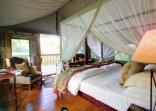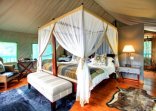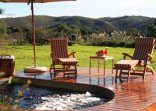
View photos and learn more
Enquire Online or call our
Helpdesk on:
087 8205 406


View photos and learn more
Each tented suite has been carefully incorporated into the surrounding Western Cape Safari bushveld while a canopy of African trees provide vital shade. The 21 suites are equipped with a minibar, telephone, safe, coffee & tea making facilities, electrical blanket, heater/air-con, guest amenities, bathrobe, slippers and have their own private deck. Raised wooden walkways connect each of the tents to the Main Lodge with its spacious lounge and open plan Fireplace Restaurant that leads onto an outside open wooden deck. Please note children ages 6 and older are welcome.
The Manor House is within walking distance from the Main Lodge and situated between the Luxury Tented Lodge. It offers 7 en-suite rooms, some with showers; and some with baths and showers. The Manor House has it’s own pool and Guests can make use of the Lodge Facilities, including the Fireplace Restaurant. Children 6 and older welcome.
The Self-Catering Bush Villas are 27km from the Main Lodge and operate on their own. Access to the Villas are via the Greatbrak River. The fully furnished Villas offers scenic Western Cape Safari views over the waterhole, a frequent meeting place for hippos, rhinos, buffalos and a variety of bird species. The Villas includes indoor and outdoor fireplaces, three en-suite bedrooms, and an open-plan dining room, kitchen and lounge. Superior Villas has a private splash pool as well. Children of all ages are welcome.

View from a distance over the river and mountain with outdoor shower and indoor free standing bath Config: Twin or Double (2 adults + 1 child 6-12yr)

Located on the riverfront with river view, outdoor shower, indoor free standing bath, coffee machine and hanging chair Config: Twin or Double (2 adults + 1 child 6-12yr)

Extra-large tent with lounge, free standing bath and outdoor shower. Splash pool outside Config: Double only (2 adults)

Fireplace Air-con Lounge area Private Patio Coffee & Tea Facilities Mini bar in room Telephone En-suite bathroom Guest amenities Bathrobe & Slippers Mosquito netts

Fireplace Air-con Lounge area Private Patio Coffee & Tea Facilities Mini bar in room Telephone En-suite bathroom Guest amenities Bathrobe & Slippers Mosquito netts

Fireplace Air-con Lounge area Private Patio Coffee & Tea Facilities Mini bar in room Telephone En-suite bathroom Guest amenities Bathrobe & Slippers Mosquito netts
.thumbnail-156x104.JPG)
Botlierskop was bought by Dr Dirk Neethling in 1996. He has been in the game farming industry since 1960 and saw the opportunity to reintroduce wildlife in this area. After 4 years of recovering from domestic farming Botlierskop was ready to open in the year 2000, allowing their guests to experience the beautiful Cape environment as it was, when wild animals still roamed freely.
In October 2001 the Fireplace Restaurant opened. This 100 seater restaurant soon earned the reputation for quality food and service.
Eight luxury tented suites overlooking the Moordkuil River were opened in September 2003. Botlierskop expanded quickly to about 3000 ha and had nine permanent guides handling the outdoor activities in 2003. In total there were more than 40 permanent staff contributing to Botlierskop’s exceptional status in the tourism industry. This luxury accommodation has proven so popular that an additional 11 suites have been added between 2006 and 2007; then totalling 19. Warm hospitality and personal service has ensured that visitors return time and again
Along with prosperity we also experienced hardship and disasters. It made the team grow stronger and Botlierskop can vouch for that!
In November 2005 a veldfire swept though the reserve, destroying 85% of the vegetation, killing 3 rhino’s and some antelopes. Although all staff, neighbouring farmers and friends, totalling 100 people, tried to prevent the main lodge and tented suites catching fire, we lost one tent and three were damaged. Botlierskop reopened in January 2006 and resumed business as usual
On the 1st of August 2006 the tented suites flooded due to heavy rains. Four tents were out of order and the rebuilding was just completed when the next flood occurred on 22 August 2006, really putting a damper on the motivation of the staff. But they persevered and rebuilt the accommodation for the coming season.
Nature took its course and on the 22nd of November 2007 the tented suites flooded again, this time the damage was extensive. The water level in eight of the tents; reached bed height. After which one tent collapsed. The entrance road also washed away which prevented access to the reserve. Botlierskop was forced to close for day visitors as well as overnight guests but thanks to the municipality, access to the reserve was regained on the 21st of December resulting in day visitor traffic to continue. The tented suites all re-opened on the 1st of May 2008 and due to relocation of the tents, only 15 were available. Fortunately, due to the owners wish no member of staff has lost their job.
On the 25th of December 2007 Mrs Magda Neethling, Dr Dirk Neethling’s wife, passed away after suffering from cancer for more than 3 years. Mrs Madga Neethling was responsible for the interior decoration of the main lodge, tented suites and conference room, which was named in memory of her.
ELEPHANT background:
In June 2004 the two elephants, Sam and Tsotsi joined the Botlierskop team. This is the first time that elephant back rides were offered in the Southern Cape. In August 2007 Tsotsi gave birth to a healthy male calf. Tshima which means surprise, as it truly was. Viv Bristow and his sons, the owners of the elephants, run the family business his father started in 1973. They help out with problem animal control. Animals (mostly orphans) from the culling [1] programs in Africa were sent abroad to establish breeding programs there.
In September 2003 with the political instability in Zimbabwe, war veterans also invaded Viv’s property. In order to save as many animals as possible, Viv moved some of his animals to the Ranch Hotel near Polokwane (former Pietersburg) in the north of South Africa. The owners of Botlierskop approached Viv in the beginning of 2004 to bring his elephants to Botlierskop and continue the educational program he started in Zimbabwe. They earn money to sustain themselves and the other animals that are still in Viv’s training camps in Zimbabwe.The two also became movie stars and featured in a couple of movies in Kenya where trained elephants were needed. Some of the movies they featured in were; ‘Far off Place’ and ‘Elephant Boy’. Tsotsi bathed with Isabella Rosselini in another movie and the latest is ‘Pride’ (released December 2004), where Sam & Tsotsi can be seen. They were also involved in most of Jamie Uys movies including ‘The Gods must be crazy’ where Jamie wanted the elephants to get drunk on Amarula fruit.
LION SANCTUARY:
In 1996, Sarah Scarth, Emergency Relief Director for the International Fund for Animal Welfare (IFAW) met with Rita Miljo, founder and director of the Centre for Animal Rehabilitation and Education (CARE), after floods nearly destroyed the centre and IFAW provided emergency relief to help during this disaster. During a visit to the center, which primarily rehabilitates orphaned baboons for release back to the wild, Sarah was shown the three orphaned lions – two males, Tau and Ngala and a female, Karata, who had been hand raised from birth by Rita after they were abandoned by their mothers.
Unfortunately, the lions had completely outgrown their once sizeable enclosure and a new home had to be found. Rita had searched for months for a place where the lions could live in the wild or semi-wild, and in peace. To her dismay, only commercial lion breeders and individuals in the hunting industry who wanted to acquire her lions for breeding or trophy hunting (or both), offered to take the lions from Rita.
With the help of Gareth Patterson, the well-know wildlife author who rescued and rehabilitated the last of the Born Free lions after his mentor George Adamson was murdered in Kenya, a new home was found not far from CARE.
While the lion’s new enclosure was being built, a young female lion cub was placed in Rita’s care. The nine-month-old Shamwari was orphaned on a lion-breeding farm and faced being arbitrarily shot if a safe home could not be found.
With the help of a R40 000 grants from IFAW, a 100 hectare sanctuary was created for the four lions, and in November 1996 they were relocated to their new safe haven. Because the lions could never be released back into the wild, the aim of the large 100-hectare sanctuary was to give them a home as close to the wild as possible. However because space was limited, further breeding had to be prevented, thus the two males each had a vasectomy before being moved. The lions would be cared for by the owners of the reserve and Rita Miljo, Sarah Scarth (IFAW) and Gareth Patterson were appointed trustees of the lions.
Here the four lions lived for the next two years, until early 1999. Due to a combination of factors, including the change of ownership of the land upon which the lions lived, it was agreed by the trustees that a new home had to be found to guarantee the lions’ long-term safety.
Rita discovered that wildlife veterinary surgeon Dirk Neethling was establishing a wildlife reserve in Mossel Bay in the Western Cape. The owners expressed a desire for the lions to be relocated to their reserve and in turn established a magnificent sanctuary for them within the Botlierskop Private Game Reserve, where these four lions would always be protected. Historically, the African lion has been extinct from this region in the Cape since the 1860’s. Therefore, it was immensely symbolic occasion when the lions were moved to Botlierskop in October 1999. The lions’ territorial calls were the first of their kind to reverberate across these valleys and mountains in almost a century and a half. With the Outeniqua Mountains in the north and the Indian Ocean in the south, the lions have finally come home. Their presence at Botlierskop Private Game Reserve marks the return of the King in the Cape.

Escape from the pressures of modern life and retreat to Kagga Kamma, located in the...

Aquila Private Game Reserve is basically wedged between the Langeberg and the Outeniqua Mountains, in...